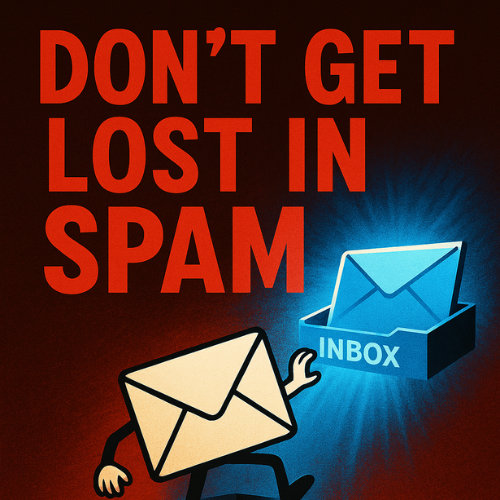Effective Email Lead Generation Strategies to Boost Conversions
Lead generation is key to growing your business. Email campaigns deliver an incredible $42 ROI for every $1 spent! Today, I’ll share simple, effective steps to turn visitors into loyal customers using email.

1. Offer Irresistible Opt-In Incentives
Give your visitors a reason to join your list:
-
Free guides, ebooks, or webinars
-
Discount codes or exclusive offers
-
Practical tools like templates or checklists
Make sure your offer matches your audience’s needs. For example:
-
B2B? Share a detailed whitepaper.
-
E-commerce? Offer a 15% discount on first purchase.
2. Optimize Your Landing Pages
A great landing page focuses on one goal: getting sign-ups.
Key elements:
-
Clear, benefit-driven headline
-
Social proof (testimonials, subscriber counts)
-
Minimal distractions, mobile-friendly design
-
Bold, action-oriented CTA button
Don’t forget to test different headlines, button colors, and layouts to find what works best.
3. Segment Your Email List
Personalize your emails by grouping subscribers based on:
-
Demographics (age, location, job title)
-
Behavior (past purchases, website activity)
-
Interests and engagement levels
Segmented campaigns can boost revenue by up to 760%! Tailor your messages to each group for better results.
4. Craft Compelling Subject Lines & Design Beautiful Emails
Your subject line decides if your email gets opened. Try:
-
Questions: “Ready to double your sales?”
-
Numbers: “5 proven ways to grow your business”
-
Personalization: “[First Name], here’s something for you”
-
Emojis: 🔥 “New features just dropped”
For the email design:
-
Use plenty of white space
-
Stick to your brand colors
-
Include high-quality images
-
Make sure it’s mobile-friendly (60% of emails are opened on phones!)
Bonus: Automate & Optimize
Use tools like make.com and n8n to automate data entry. Warm-up your email to avoid spam folders. Set up workflows to nurture leads automatically and keep testing for better results.
Ready to Grow Your Leads?
Start by creating an irresistible opt-in and optimizing your landing page today!
👉 Book a strategy call with me now!
Email Marketing vs Paid Ads: Which Delivers Better ROI?
email marketing and paid ads offer unique advantages and challenges. Understanding their differences, strengths, and how innovations like AI automation affect their performance is crucial for maximizing your marketing efforts.

Defining the Channels
In today’s digital marketing landscape, businesses face the challenge of choosing the most effective channels to drive growth. Two popular strategies-email marketing and paid ads-offer unique advantages and challenges. Understanding their differences, strengths, and how innovations like AI automation affect their performance is crucial for maximizing your marketing efforts.
What is Email Marketing?
Email marketing involves sending targeted messages directly to a subscriber’s inbox. It nurtures relationships by providing personalized content, promotions, or updates tailored to the recipient’s preferences.
Key Benefits of Email Marketing:
Builds long-term customer relationships
Leverages existing contact lists
Supports segmentation and personalization
What are Paid Ads?
Paid ads are advertisements placed on platforms like Google, Facebook, Instagram, or LinkedIn, where marketers pay per click or impression. These ads target potential customers based on demographics, interests, and behaviors.
Key Benefits of Paid Ads:
Immediate traffic generation
Broad audience reach
Flexible targeting options
Comparing ROI and Conversion Rate
Return on Investment (ROI)
| Channel | Typical ROI | Cost Factors |
|---|---|---|
| Email Marketing | High ($38 for every $1 spent)* | Low cost per message; minimal platform fees |
| Paid Ads | Moderate to high (varies widely) | Costs vary by auction competition and bidding strategy |
*Source: DMA Report
Email marketing often delivers superior ROI due to low operational costs and the ability to foster repeat business. Paid ads provide faster visibility but come with ongoing expenses that can reduce profit margins if not managed carefully.
Conversion Rate Differences
Email marketing: Generally higher conversion rates since recipients have already expressed interest by subscribing.
Paid ads: Conversion rates depend heavily on ad quality, landing page relevance, and targeting precision.
The Role of AI Automation in Enhancing Performance
AI automation is reshaping how marketers approach both email marketing and paid ads by improving efficiency and results.
In Email Marketing:
Automates segmentation based on engagement metrics
Personalizes subject lines and content dynamically
Triggers timely follow-ups based on user actions
In Paid Ads:
Optimizes bidding strategies using machine learning
Predicts audience segments likely to convert
Creates dynamic ad creatives tailored to each viewer
Using AI automation reduces manual workload and makes campaigns more adaptive, improving conversion rates without necessarily increasing budgets.
Advantages & Disadvantages Breakdown
| Channel | Advantages | Disadvantages |
|---|---|---|
| Email Marketing | High ROI, personalization, low cost | Requires existing list, slower to scale |
| Paid Ads | Fast traffic, broad reach, flexible targeting | Higher ongoing costs, variable ROI |
Choosing the Right Strategy for Your Business
Consider these factors when deciding between email marketing and paid ads:
Audience Stage: Use email marketing for nurturing existing leads; use paid ads for brand awareness or acquiring new leads.
Budget Constraints: Start with email marketing if budget is limited; scale paid ads with clear ROI tracking.
Business Goals: Focus on conversion rates if immediate sales are a priority; prioritize engagement metrics for long-term loyalty.
Technology Access: Leverage AI automation tools available within your platforms to maximize efficiency.
Integrating Both Channels for Maximum Impact
Rather than viewing email marketing and paid ads as competitors, combining them creates synergy:
Use paid ads to build your email list quickly
Send personalized emails triggered by ad interactions
Retarget email subscribers with customized paid ads offers
Analyze data across both channels through AI-powered dashboards
This integration enhances overall conversion rates while optimizing spend efficiency.
Final Thoughts
Marketing success hinges not just on choosing between email marketing or paid ads but on understanding how each fits into your broader strategy, enhanced by AI automation tools. Crafting a balanced mix tailored to your business needs ensures better ROI over time.
If you want, I can help you create visuals, infographics, or call-to-action buttons to complement this blog on your website! Would you like assistance with that?
Avoid These Common Email Marketing Mistakes to Maximize Success
many businesses fall into traps that undermine their campaigns, resulting in low open rates, poor engagement, and missed opportunities. Understanding and avoiding common email marketing mistakes can dramatically improve your results.

The Impact of Email Marketing Mistakes
Even small errors can reduce the effectiveness of your campaigns. These mistakes waste resources and can damage your brand reputation. Identifying issues early allows you to optimize your strategy for better results.
Common consequences include:
High unsubscribe rates
Low click-through rates
Increased spam complaints
Reduced customer trust
Avoiding these pitfalls is crucial for maintaining a healthy email list and maximizing ROI.
Top Email Marketing Mistakes to Avoid
1. Neglecting List Segmentation
Sending the same message to everyone ignores your audience’s diverse interests and needs. Segmentation lets you tailor content based on demographics, behavior, or purchase history.
Problems caused by poor segmentation:
Irrelevant content lowers engagement
More unsubscribes due to poor targeting
Missed opportunities for personalized offers
Tip: Divide your list into meaningful groups-new subscribers, loyal customers, inactive users, etc.
2. Ignoring Mobile Optimization
More than half of emails are opened on mobile devices. If your emails don’t display correctly, you’ll lose clicks and frustrate users.
Signs of poor mobile optimization:
Tiny, hard-to-read text
Buttons too close together or hard to tap
Images not scaling properly
Tip: Use responsive design templates and test across multiple devices before sending.
3. Overlooking Subject Line Importance
Your subject line is the first impression. Weak or misleading subject lines drastically reduce open rates.
Common mistakes:
Too generic or vague
Clickbait that disappoints
Fails to convey value or urgency
Tip: Write concise, clear subject lines that highlight benefits or spark curiosity-without exaggeration.
4. Spamming Subscribers with Excessive Emails
Sending too many emails causes fatigue and annoyance, leading to unsubscribes or spam complaints.
Effects of over-emailing:
Decreased engagement
Negative brand perception
Higher spam complaint rates
Tip: Set a consistent, reasonable sending frequency based on subscriber preferences and campaign goals.
5. Lack of Clear Call-to-Actions (CTAs)
Emails without a clear CTA confuse recipients about what to do next, reducing conversion potential.
Characteristics of weak CTAs:
Too many competing CTAs
Vague language (“Click here”)
Buttons/links that blend into the background
Tip: Use a single, prominent CTA with compelling text aligned to your campaign objective.
Effective Email Personalization Tips
Personalization is more than just adding a name. It’s about making every message relevant.
1. Use Dynamic Content Blocks
Show different content based on recipient data (location, purchase history, browsing behavior).
Examples:
Product recommendations based on past purchases
Local event info based on geography
2. Send Triggered Emails Based on Behavior
Automate campaigns that respond to actions like abandoned carts, purchases, or sign-ups.
Benefits:
Timely communication when interest is highest
Improved conversions with relevant messaging
3. Personalize Send Times
Analyze when each subscriber is most likely to open emails and schedule accordingly.
Result: Higher open rates by reaching people during their peak engagement times.
4. Leverage Data Beyond Names
Use details like birthdays, loyalty status, or past interactions for deeper connections.
Example:
“Happy Birthday! Here’s an exclusive discount just for you.”
Measuring Success & Continuous Improvement
Track key metrics to spot mistakes and see which personalization tactics work:
| Metric | Purpose |
|---|---|
| Open Rate | Measures subject line effectiveness |
| Click-through Rate | Indicates content relevance |
| Conversion Rate | Tracks achievement of campaign goals |
| Bounce Rate | Shows quality of your email list |
| Unsubscribe Rate | Reveals subscriber satisfaction |
Regularly review these metrics and A/B test to refine your strategy.
Summary Checklist: Avoiding Email Marketing Mistakes
Segment your email lists thoughtfully
Optimize designs for mobile devices
Write compelling, honest subject lines
Limit send frequency to prevent fatigue
Include clear, focused CTAs
Personalization Tips:
Use dynamic content blocks tailored by behavior/data
Automate triggered emails based on user actions
Personalize send times per recipient habits
Incorporate diverse personal data beyond names
Mastering these fundamentals will set your email campaigns up for maximum engagement and success in today’s competitive digital landscape.
